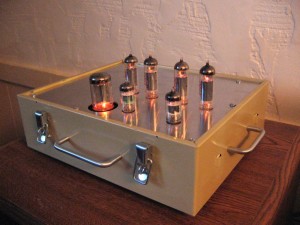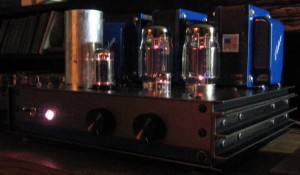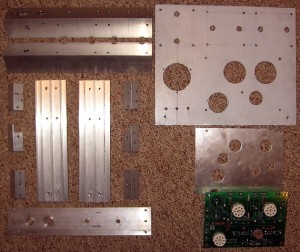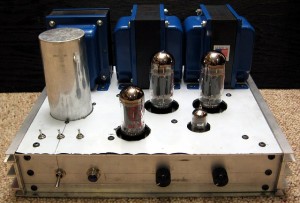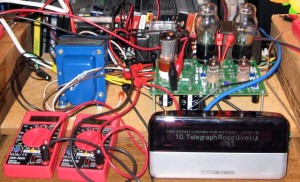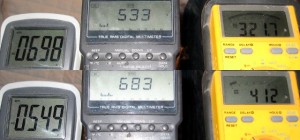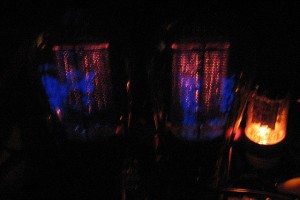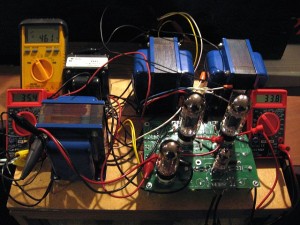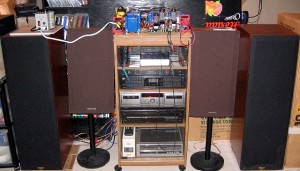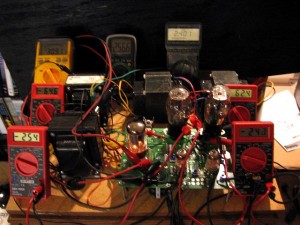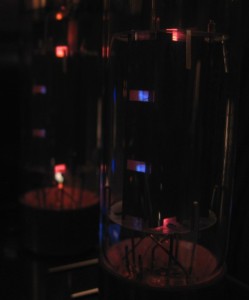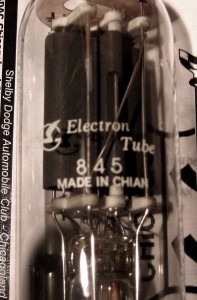Electron Tube Audio
This section is devoted to my electron tube audio projects. Some are modifications to existing amplifiers, while others are “from scratch” designs by yours truly. The projects are listed below, in the approximate order of their inception:
- Thomas PA – 6V6GT push-pull beam tetrode power amplifier
- Buttons – 12AU7 line stage preamp with all the buttons
- Dad’s PA – “Williamson” push-pull pentode power amplifier
- Dynakit ST-70 – an old, dead Stereo 70 in need of resurrection
- Tubelab Simple SE – single-ended triode/ultralinear power amplifier
- Tubelab SE – 45/300B single-ended directly-heated triode power amplifier
- Tubelab Simple PP – EL84/6CW5 push-pull power amplifier
- Harman-Kardon A50K – 7355 push-pull integrated amplifier
Tubelab Simple PP
by Russ Knize on Apr.28, 2010, under Electron Tube Audio
George from Tubelab was kind enough to send me his latest PCB and some iron for a test build. Easy build and the result was tossed into a disused lock box.
Simple SE – Fire in the Bottles
by Russ Knize on May.05, 2009, under Electron Tube Audio
1 Comment :Tubes more...Tubelab Simple SE Chassis Fitting
by Russ Knize on Apr.17, 2009, under Electron Tube Audio
All of the cutting and milling and drilling is finally done.
Here are all the various bits and pieces, made mostly from scraps, all put together:
More about the build here. Next step is paint….
Tubelab SE Breadboard with 300Bs
by Russ Knize on Apr.15, 2009, under Electron Tube Audio
With a custom power transformer from Edcor, I could finally try this amp with some borrowed 300Bs. This transformer’s primary is tapped so that it can be used with either 300Bs or 45s:
XPWR131 - 330-260-0-260-330 @ 175mA, 6.3 V CT @ 4A, 5V @ 3A
Voltages came in a bit high, even under load. The top row is the Tubelab SE in “45 mode”, with about 25mA per tube. Meters are reading: 660VAC winding, 520VAC winding, B+ at the filter cap. Bottom row is in “300B mode”, running Shuguang 300Bs (not mine) at about 28mA per tube. First two meters got swapped: 520VAC winding, 660VAC winding, B+.
With the 300Bs biased to 80mA, the 660VAC winding gets pulled down exactly to spec: 660VAC. B+ sags to around 370-375 VDC. Supposedly this is the ideal spot for the 300B. These tubes are Shuguang’s aptly-named “300BS”, which have mesh plates and globe-shaped glass. They have a weird blue glow on the glass, presumably from electrons flying through the gaps in the mesh.
Tubelab Simple SE Breadboard
by Russ Knize on Mar.22, 2009, under Electron Tube Audio
With the right iron, the Tubelab Simple SE comes to life. After a sanity-check with cheap Chinese tubes, here is the amp running with JJ 6L6GCs strapped as triodes. The amp sounds sweet with a bit more power than the Tubelab SE.
This coincides with the new speakers that I recently got off of Craigslist: a pair of Klipsch KLF-10s. The horns on these do cause ear fatigue on the Dynaco, but with this amp it is more subdued. I am hoping that the DHTs in the Tubelab SE will be even better.
The basement in currently under construction, so the setup is a bit MacGyver.
Tubelab SE Breadboard
by Russ Knize on Mar.16, 2009, under Electron Tube Audio
So I’ve finally built-up this Tubelab SE, a small, single-ended, 2 watt amp. It’s currently in breadboard form, but it sounds amazing. Awesome detail, impressive bass, and something warm about the sound.
Tube Fluorescence
by Russ Knize on Feb.03, 2009, under Electron Tube Audio
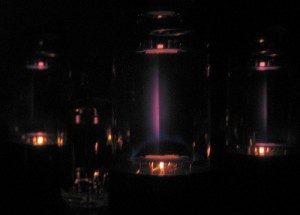
These are the output tubes on my Thomas amp. You can see the blue glow against the glass from stray electrons. This is very common with Sylvania tubes. Behind the blue glow, is the red glowing line from the electron beam hitting the plates (I can’t get the bias to go any lower with this amp). The two together look purple to the camera.
I have read contradictory discussions about blue glow against the glass envelope. Blue glow coming from inside or near the anode or other structures is normal, but some say that blue glow outside of that means a soft vacuum. Sylvania claims the opposite and that fluorescent glow inside the envelope is normal for some tubes. It results from stray electrons bombarding near the glass envelope and will change in brightness depending on the intensity of the signal passing through the tube. This is exactly what I see with these Philips JAN tubes, which are basically Sylvania. In fact when I push the amp really hard well into cut-off, the tubes will flash brightly signaling me to back-off
The “Winged-C” SED EL34s in the Dynakit seem to fluoresce at the screen behind the plate:
Why Tubes?
by Russ Knize on Feb.01, 2003, under Electron Tube Audio
Why thermionic electron emission devices (valves to our friends in the UK)? Well, I grew up listening to my LPs, cassettes, and the radio through a 6V6GT push-pull instrument amplifier and eventually found that I really missed its sound. I actually didn’t know what it was I didn’t like about my audio system until I fired up that old amp again. The brash, gritty sound was gone. See my Thomas 6V6GT PP amp for more about that. I don’t consider myself to be an audiophile, however the difference to me is noticeable. For an excellent article with a bit of empirical evidence, take a look at Tubes Vs. Transistors by Russell O. Hamm.
The other part of the answer to this question is that I enjoy the challenge as much as (if not more than) the results of my efforts. In terms of components in the signal path, electron tube amplifiers are about as simple as it can get. Perhaps some of the healthy fear involved in working with lethal voltages has something to do with it as well. 🙂 Finally, tubes are just damn cool. They operate on such a macro scale that you can actually “see” the process take place inside them that is providing you with service that you took the time to design/modify. They’re also pretty to look at….
Disclaimer: All of the projects described in these web pages use dangerous and potentially LETHAL voltages, materials, and components. This material is intended for advanced electronics experimenters only. The author assumes no liability for damages incurred through the use or misuse of the information provided herein. This information is provided "as is" and without warranties as to performance of or any other warranties whether expressed or implied. No warranty of fitness for a particular purpose is offered.
